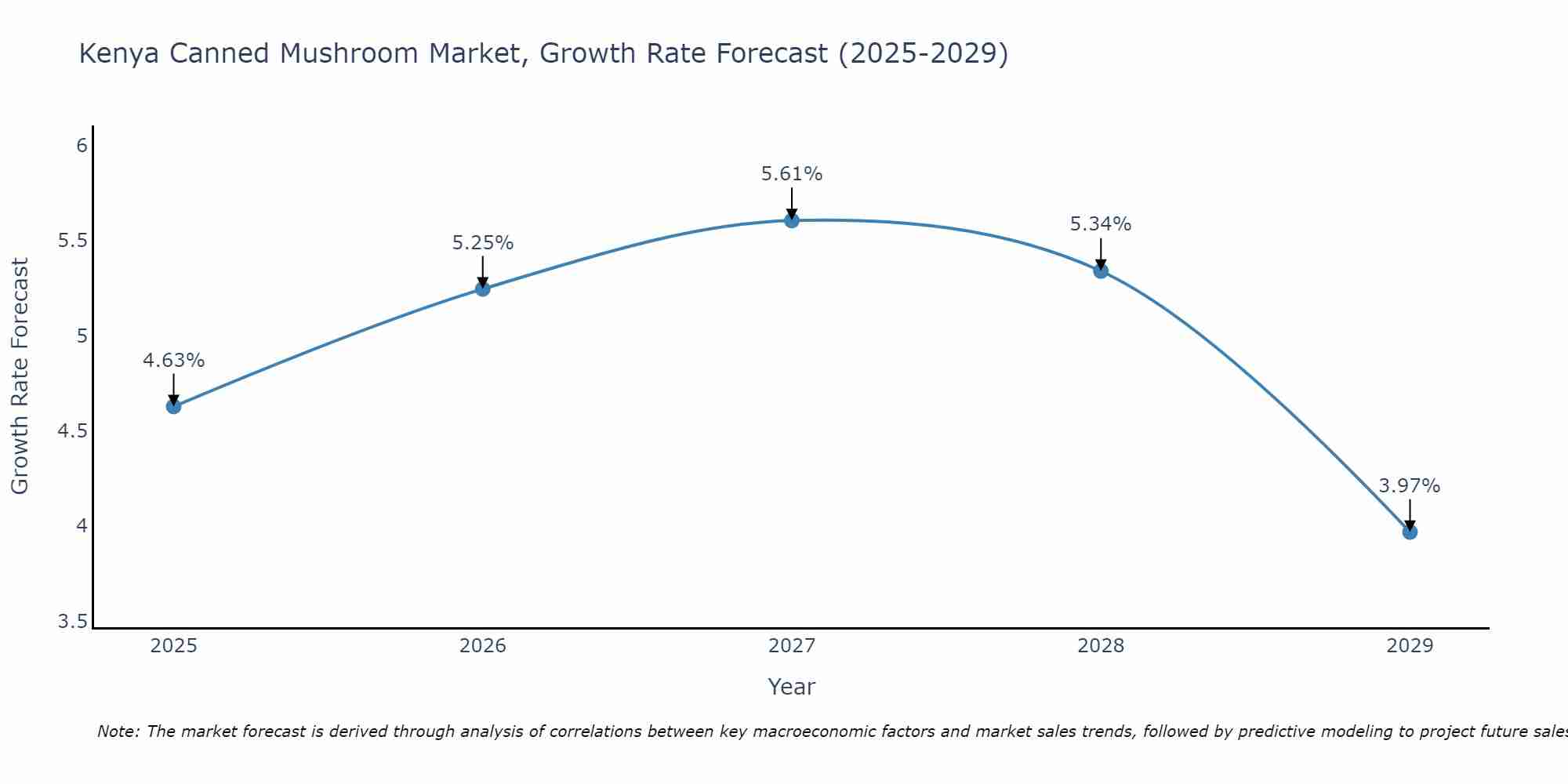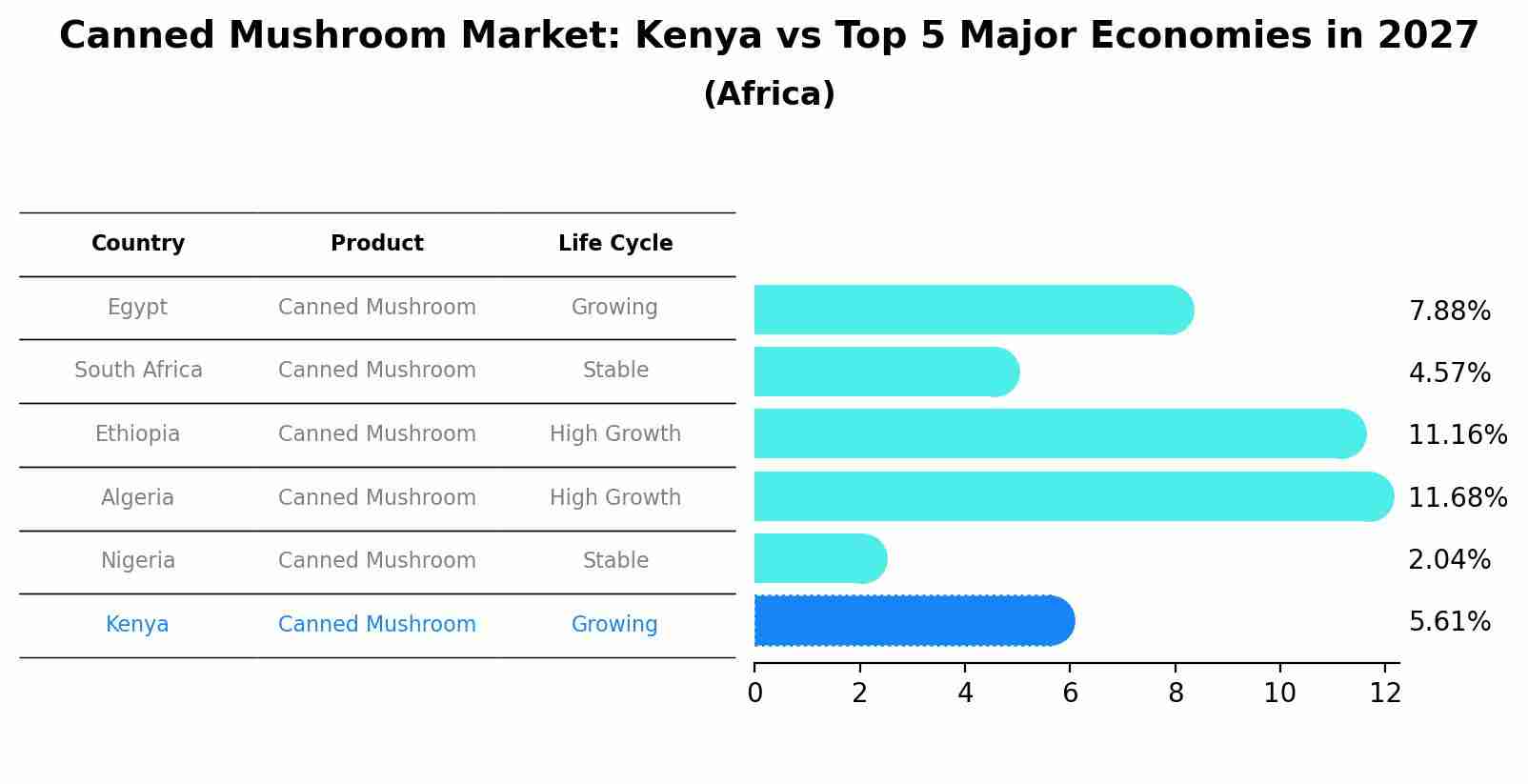Kenya Canned Mushroom Market Outlook | Industry, Revenue, Trends, Forecast, Growth, Share, Value, Companies, COVID-19 IMPACT, Size & Analysis
| Product Code: ETC108669 | Publication Date: Jun 2021 | Updated Date: Sep 2025 | Product Type: Report | |
| Publisher: 6Wresearch | Author: Ravi Bhandari | No. of Pages: 70 | No. of Figures: 35 | No. of Tables: 5 |
Kenya Canned Mushroom Market Size Growth Rate
The Kenya Canned Mushroom Market is projected to witness mixed growth rate patterns during 2025 to 2029. The growth rate begins at 4.63% in 2025, climbs to a high of 5.61% in 2027, and moderates to 3.97% by 2029.

Canned Mushroom Market: Kenya vs Top 5 Major Economies in 2027 (Africa)
By 2027, Kenya's Canned Mushroom market is forecasted to achieve a growing growth rate of 5.61%, with Egypt leading the Africa region, followed by South Africa, Ethiopia, Algeria and Nigeria.

Kenya Canned Mushroom Market Overview
The canned mushroom market in Kenya is experiencing steady growth, driven by the increasing demand for convenient and nutritious food options. Canned mushrooms are valued for their versatility, long shelf life, and ease of preparation, making them a popular choice among consumers and foodservice providers. Additionally, as consumers become more health-conscious and seek plant-based alternatives, the demand for canned mushrooms as a meat substitute is on the rise. With the government`s initiatives to promote food processing and support agricultural diversification, the canned mushroom market is poised for further expansion, offering consumers a convenient and sustainable source of protein.
Drivers of the market
The Kenya Canned Mushroom market is experiencing growth propelled by the increasing demand for convenience foods and the expanding food processing industry. Canned mushrooms offer year-round availability, extended shelf life, and ease of preparation, making them popular ingredients in various culinary applications, including soups, sauces, pizzas, and salads. The growing consumer preference for gourmet and international cuisines, coupled with the rising awareness about the nutritional benefits of mushrooms, is driving the demand for canned mushrooms in Kenya. Moreover, the versatility of canned mushrooms in recipes and their ability to enhance flavor and texture are contributing to market growth. Additionally, the expansion of distribution channels, including supermarkets, specialty stores, and online platforms, is increasing accessibility to canned mushroom products, thereby fueling market expansion.
Challenges of the market
The canned mushroom market in Kenya encounters challenges related to production costs, seasonality, and consumer preferences. While canned mushrooms offer convenience and longer shelf life compared to fresh mushrooms, production costs and availability of raw materials can impact pricing and profitability. Moreover, consumer preferences for fresh and locally sourced mushrooms may limit the market potential for canned varieties. Additionally, market seasonality and fluctuations in demand pose challenges for production planning and inventory management.
Government Policy of the market
To promote the mushroom cultivation industry and value addition, the Kenya government has implemented policies to support the canned mushroom market. These policies include research and development funding for mushroom farming, quality control standards for canning processes, and marketing initiatives to boost consumer awareness and demand for canned mushrooms.
Key Highlights of the Report:
- Kenya Canned Mushroom Market Outlook
- Market Size of Kenya Canned Mushroom Market, 2020
- Forecast of Kenya Canned Mushroom Market, 2027
- Historical Data and Forecast of Kenya Canned Mushroom Revenues & Volume for the Period 2018 - 2027
- Kenya Canned Mushroom Market Trend Evolution
- Kenya Canned Mushroom Market Drivers and Challenges
- Kenya Canned Mushroom Price Trends
- Kenya Canned Mushroom Porter's Five Forces
- Kenya Canned Mushroom Industry Life Cycle
- Historical Data and Forecast of Kenya Canned Mushroom Market Revenues & Volume By Product for the Period 2018 - 2027
- Historical Data and Forecast of Kenya Canned Mushroom Market Revenues & Volume By Button for the Period 2018 - 2027
- Historical Data and Forecast of Kenya Canned Mushroom Market Revenues & Volume By Shiitake for the Period 2018 - 2027
- Historical Data and Forecast of Kenya Canned Mushroom Market Revenues & Volume By Oyster for the Period 2018 - 2027
- Historical Data and Forecast of Kenya Canned Mushroom Market Revenues & Volume By Morel for the Period 2018 - 2027
- Historical Data and Forecast of Kenya Canned Mushroom Market Revenues & Volume By Other for the Period 2018 - 2027
- Historical Data and Forecast of Kenya Canned Mushroom Market Revenues & Volume By Application for the Period 2018 - 2027
- Historical Data and Forecast of Kenya Canned Mushroom Market Revenues & Volume By Household for the Period 2018 - 2027
- Historical Data and Forecast of Kenya Canned Mushroom Market Revenues & Volume By Restaurants for the Period 2018 - 2027
- Kenya Canned Mushroom Import Export Trade Statistics
- Market Opportunity Assessment By Product
- Market Opportunity Assessment By Application
- Kenya Canned Mushroom Top Companies Market Share
- Kenya Canned Mushroom Competitive Benchmarking By Technical and Operational Parameters
- Kenya Canned Mushroom Company Profiles
- Kenya Canned Mushroom Key Strategic Recommendations
Frequently Asked Questions About the Market Study (FAQs):
1 Executive Summary |
2 Introduction |
2.1 Key Highlights of the Report |
2.2 Report Description |
2.3 Market Scope & Segmentation |
2.4 Research Methodology |
2.5 Assumptions |
3 Kenya Canned Mushroom Market Overview |
3.1 Kenya Country Macro Economic Indicators |
3.2 Kenya Canned Mushroom Market Revenues & Volume, 2020 & 2027F |
3.3 Kenya Canned Mushroom Market - Industry Life Cycle |
3.4 Kenya Canned Mushroom Market - Porter's Five Forces |
3.5 Kenya Canned Mushroom Market Revenues & Volume Share, By Product, 2020 & 2027F |
3.6 Kenya Canned Mushroom Market Revenues & Volume Share, By Application, 2020 & 2027F |
4 Kenya Canned Mushroom Market Dynamics |
4.1 Impact Analysis |
4.2 Market Drivers |
4.2.1 Increasing consumer awareness about the health benefits of mushrooms |
4.2.2 Growing demand for convenient and ready-to-eat food products |
4.2.3 Expansion of distribution channels and retail outlets for canned mushrooms in Kenya |
4.3 Market Restraints |
4.3.1 Seasonal availability and fluctuations in mushroom supply |
4.3.2 Competition from fresh mushroom products |
4.3.3 Price fluctuations in raw materials impacting production costs |
5 Kenya Canned Mushroom Market Trends |
6 Kenya Canned Mushroom Market, By Types |
6.1 Kenya Canned Mushroom Market, By Product |
6.1.1 Overview and Analysis |
6.1.2 Kenya Canned Mushroom Market Revenues & Volume, By Product, 2018 - 2027F |
6.1.3 Kenya Canned Mushroom Market Revenues & Volume, By Button, 2018 - 2027F |
6.1.4 Kenya Canned Mushroom Market Revenues & Volume, By Shiitake, 2018 - 2027F |
6.1.5 Kenya Canned Mushroom Market Revenues & Volume, By Oyster, 2018 - 2027F |
6.1.6 Kenya Canned Mushroom Market Revenues & Volume, By Morel, 2018 - 2027F |
6.1.7 Kenya Canned Mushroom Market Revenues & Volume, By Other, 2018 - 2027F |
6.2 Kenya Canned Mushroom Market, By Application |
6.2.1 Overview and Analysis |
6.2.2 Kenya Canned Mushroom Market Revenues & Volume, By Household, 2018 - 2027F |
6.2.3 Kenya Canned Mushroom Market Revenues & Volume, By Restaurants, 2018 - 2027F |
7 Kenya Canned Mushroom Market Import-Export Trade Statistics |
7.1 Kenya Canned Mushroom Market Export to Major Countries |
7.2 Kenya Canned Mushroom Market Imports from Major Countries |
8 Kenya Canned Mushroom Market Key Performance Indicators |
8.1 Percentage increase in online searches for canned mushroom recipes in Kenya |
8.2 Number of new product launches and innovations in the canned mushroom market |
8.3 Growth in the number of partnerships with local farmers for a stable mushroom supply |
9 Kenya Canned Mushroom Market - Opportunity Assessment |
9.1 Kenya Canned Mushroom Market Opportunity Assessment, By Product, 2020 & 2027F |
9.2 Kenya Canned Mushroom Market Opportunity Assessment, By Application, 2020 & 2027F |
10 Kenya Canned Mushroom Market - Competitive Landscape |
10.1 Kenya Canned Mushroom Market Revenue Share, By Companies, 2020 |
10.2 Kenya Canned Mushroom Market Competitive Benchmarking, By Operating and Technical Parameters |
11 Company Profiles |
12 Recommendations |
13 Disclaimer |
- Single User License$ 1,995
- Department License$ 2,400
- Site License$ 3,120
- Global License$ 3,795
Search
Thought Leadership and Analyst Meet
Our Clients
Related Reports
- Germany Breakfast Food Market (2026-2032) | Industry, Share, Growth, Size, Companies, Value, Analysis, Revenue, Trends, Forecast & Outlook
- Australia Briquette Market (2025-2031) | Growth, Size, Revenue, Forecast, Analysis, Trends, Value, Share, Industry & Companies
- Vietnam System Integrator Market (2025-2031) | Size, Companies, Analysis, Industry, Value, Forecast, Growth, Trends, Revenue & Share
- ASEAN and Thailand Brain Health Supplements Market (2025-2031) | Strategy, Consumer Insights, Analysis, Investment Trends, Opportunities, Growth, Size, Share, Industry, Revenue, Segments, Value, Segmentation, Supply, Forecast, Restraints, Outlook, Competition, Drivers, Trends, Demand, Pricing Analysis, Competitive, Strategic Insights, Companies, Challenges
- ASEAN Bearings Market (2025-2031) | Strategy, Consumer Insights, Analysis, Investment Trends, Opportunities, Growth, Size, Share, Industry, Revenue, Segments, Value, Segmentation, Supply, Forecast, Restraints, Outlook, Competition, Drivers, Trends, Demand, Pricing Analysis, Competitive, Strategic Insights, Companies, Challenges
- Europe Flooring Market (2025-2031) | Outlook, Share, Industry, Trends, Forecast, Companies, Revenue, Size, Analysis, Growth & Value
- Saudi Arabia Manlift Market (2025-2031) | Outlook, Size, Growth, Trends, Companies, Industry, Revenue, Value, Share, Forecast & Analysis
- Uganda Excavator, Crane, and Wheel Loaders Market (2025-2031) | Strategy, Consumer Insights, Analysis, Investment Trends, Opportunities, Growth, Size, Share, Industry, Revenue, Segments, Value, Segmentation, Supply, Forecast, Restraints, Outlook, Competition, Drivers, Trends, Demand, Pricing Analysis, Competitive, Strategic Insights, Companies, Challenges
- Rwanda Excavator, Crane, and Wheel Loaders Market (2025-2031) | Strategy, Consumer Insights, Analysis, Investment Trends, Opportunities, Growth, Size, Share, Industry, Revenue, Segments, Value, Segmentation, Supply, Forecast, Restraints, Outlook, Competition, Drivers, Trends, Demand, Pricing Analysis, Competitive, Strategic Insights, Companies, Challenges
- Kenya Excavator, Crane, and Wheel Loaders Market (2025-2031) | Strategy, Consumer Insights, Analysis, Investment Trends, Opportunities, Growth, Size, Share, Industry, Revenue, Segments, Value, Segmentation, Supply, Forecast, Restraints, Outlook, Competition, Drivers, Trends, Demand, Pricing Analysis, Competitive, Strategic Insights, Companies, Challenges
Industry Events and Analyst Meet
Whitepaper
- Middle East & Africa Commercial Security Market Click here to view more.
- Middle East & Africa Fire Safety Systems & Equipment Market Click here to view more.
- GCC Drone Market Click here to view more.
- Middle East Lighting Fixture Market Click here to view more.
- GCC Physical & Perimeter Security Market Click here to view more.
6WResearch In News
- Doha a strategic location for EV manufacturing hub: IPA Qatar
- Demand for luxury TVs surging in the GCC, says Samsung
- Empowering Growth: The Thriving Journey of Bangladesh’s Cable Industry
- Demand for luxury TVs surging in the GCC, says Samsung
- Video call with a traditional healer? Once unthinkable, it’s now common in South Africa
- Intelligent Buildings To Smooth GCC’s Path To Net Zero


















